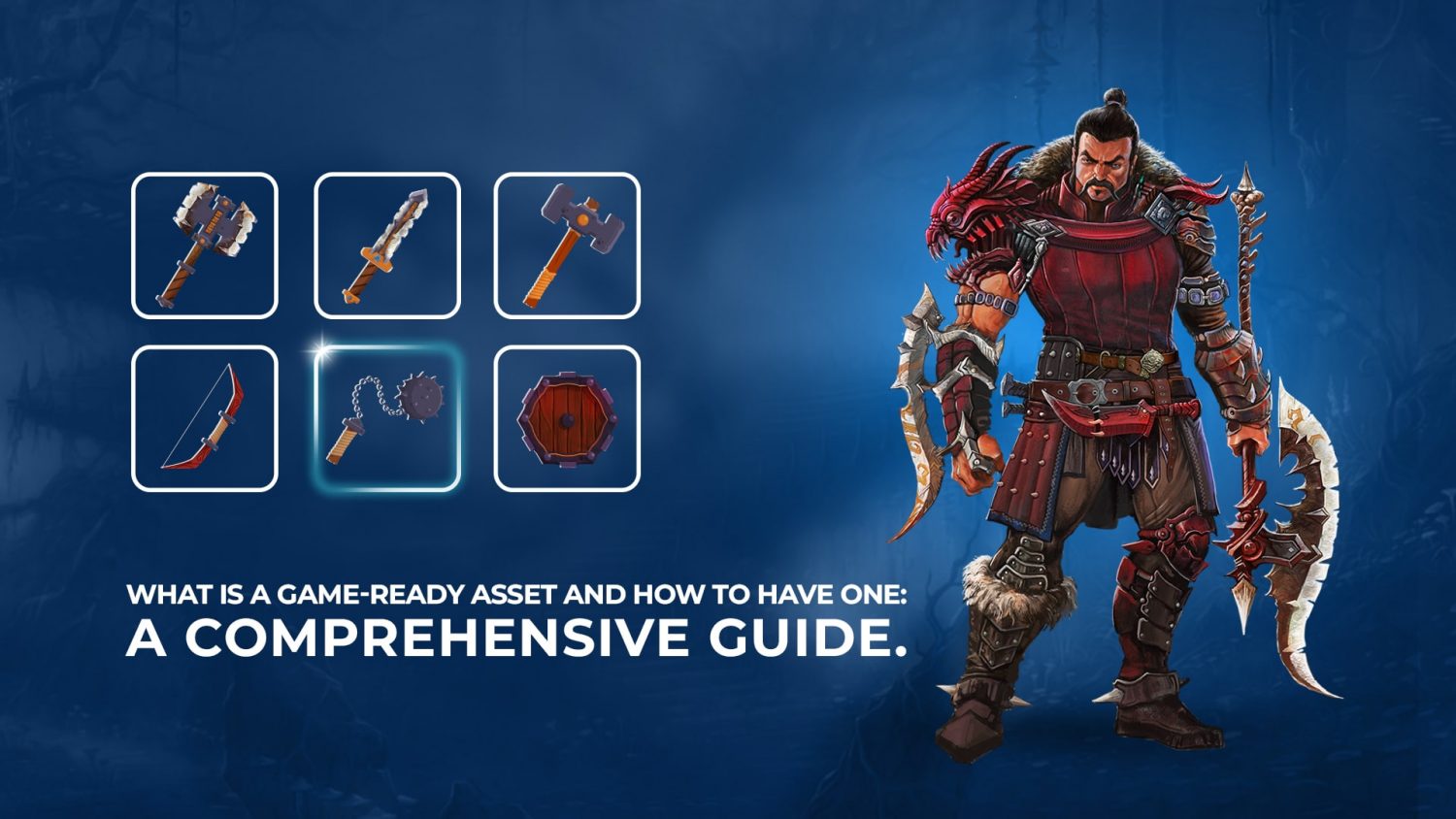Many people go through the internet to shop for game-ready assets and use them for their projects. You might have done it too.
Unfortunately, customers usually end up wasting a lot of money because they don’t know what a good and game-ready asset is. In other cases, the authors don’t provide support after selling their creations, leaving the customer confused with a mess of a group of files.
If you don’t want to make the same mistakes and know the criteria that certify them as “game-ready,” then don’t miss out on this blog.
What Is a Game-Ready Asset?
In the world of 3D modeling, you often hear the phrase “game-ready asset.” What does it imply when an asset is described as “game-ready” in online marketplaces? What distinguishes a game-ready asset from a standard model?
First, we need to know what a game asset is.
A game consists of millions of pieces of content. Characters, objects, textures, shadows, animations, and sounds are all game assets.
Look at Unreal’s asset pack for a medieval dungeon.
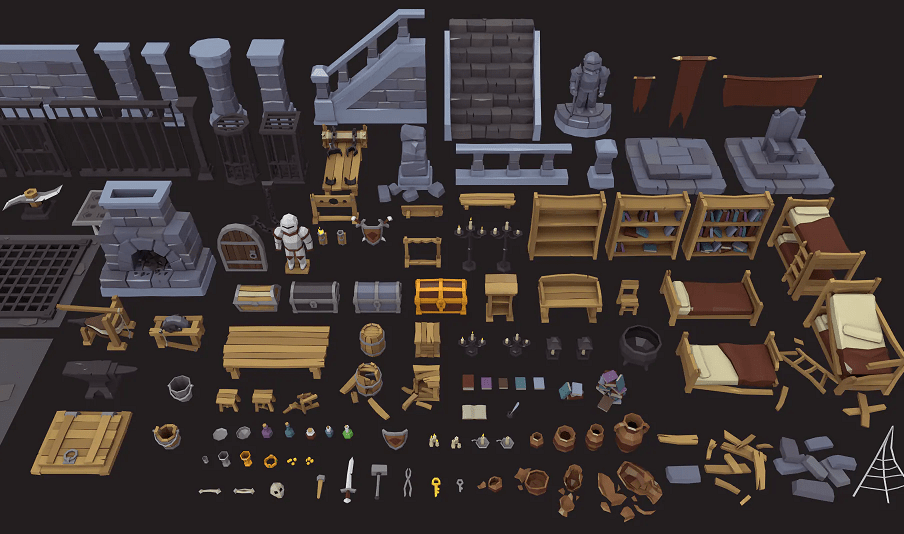
Now, when do we call these assets “game-ready”?
Models that have been optimized for real-time rendering in video games are referred to as “game-ready assets” or “models” in the industry.
An asset that is ready for use in a game will often be a mesh with a minimal polygon count, doesn’t waste triangles, and can bend and perform well. Most of the time, textures are “baked” from a high-poly source, and the final materials are constructed in the game engine used to show it. Large textures that include a significant amount of unused space are often considered to be of amateur quality, hence not “game ready.” The same goes for when the materials and textures that truly depict the content or object and its aesthetic are not shown.
In many cases, an asset ready for film or a video game trailer goes on to be sold as a game asset. But after being imported into an engine, the flaws pop up.
For example, the character might be too big or small for the engine. Or the rigs’ format may not go with the formats that the engine supports.
When it comes to game-ready assets, what matters most is performance.
A very important point that is often disregarded is ‘organization’.
Some may develop a very professional and optimized game asset but confuse the consumer due to complicated naming and disorganized groups of meshes. So be careful about naming each asset of different sizes and spheres so that your clients can have a clear understanding of the files.
Let’s proceed.
Very broadly speaking, to make a game asset, you need:
- Art programs to create the concept
- 3D modeling programs to sculpt the three-dimensional shape of an asset
- Game asset management software to save and reuse your creation
So, as you can already tell, a lot of work goes into the process. That’s why you should make sure the creation of your game-ready assets is in good hands.
Where Do You Need to Use a Game-Ready Asset?
If you are new to this industry, you should be aware that non-game-ready assets (let’s say typical assets) are both heavy and complicated for computers of any size to process. In every industry, a live graphical character is needed – one that can walk, wear things, and be rigged enough to seem real. In order for the game (or Metaverse, etc.) platform to be able to render the object in real-time, your asset should be light and discernible. A game-ready asset may be used in:
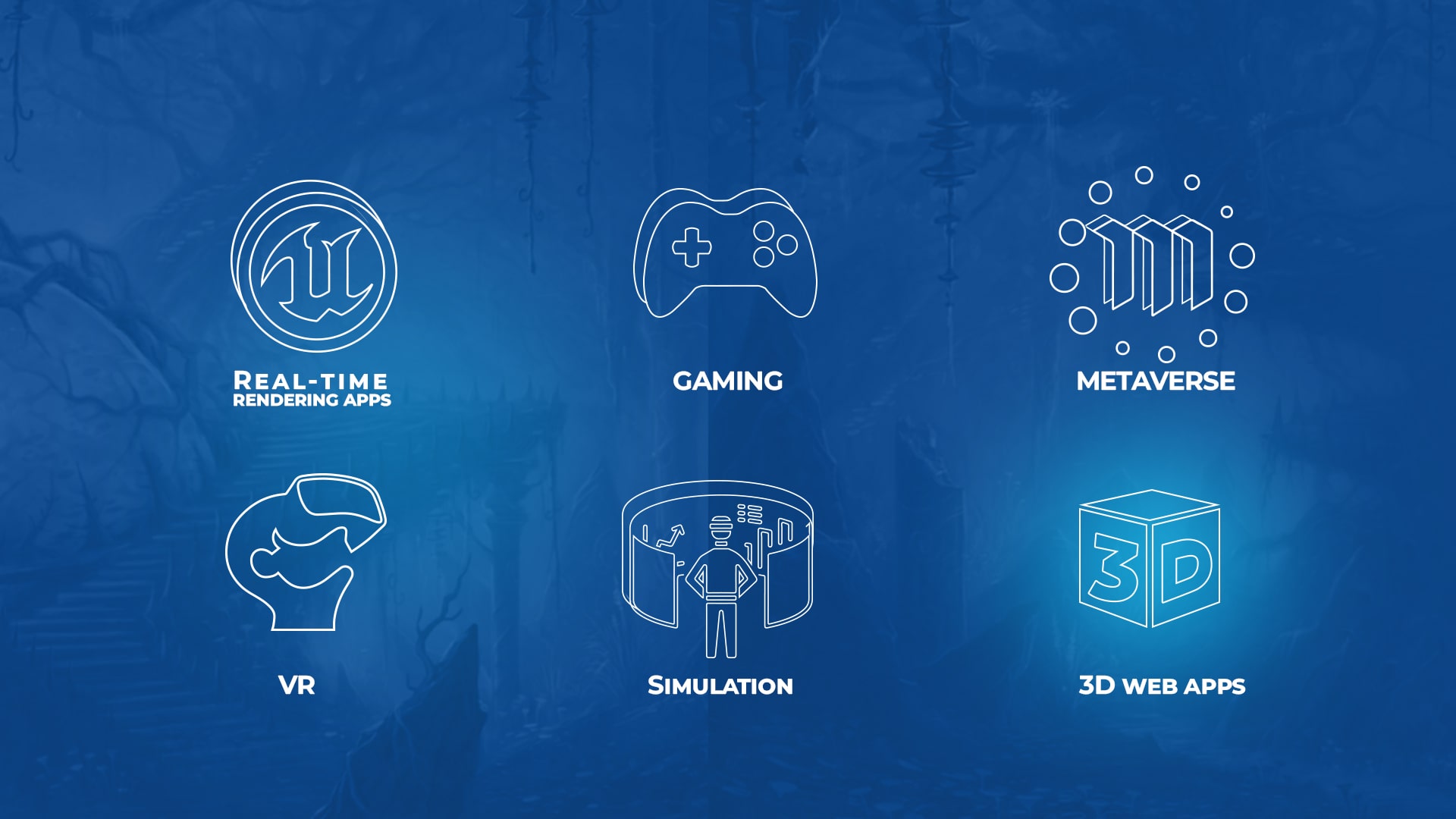
- Any real-time rendering application that needs a smooth run
- Game industry (indie games or AAA games)
- Mobile gaming development
- Metaverse
- VR (Virtual Reality video games and applications)
- Simulation (flight or racing simulator)
- 3D web applications
Whether the asset is a Maya/Max file, FBX file with texture, a Substance Painter file, or in-engine, the “finished” or “final” content has to be “ready for use”. The customer should not have to waste their time optimizing it.
Here, we will see what features turn an asset into a game-ready asset.
The Characteristics of a Game-Ready Asset
The bare minimum requirement for a 3D asset to be considered game-ready is having a decreased poly count. This is crucial as it needs to handle the real-time rendering a game engine uses. However, a lower poly count does not always indicate that the asset is of high quality. There are a variety of additional characteristics that a game-ready asset could have, some of which are listed below.
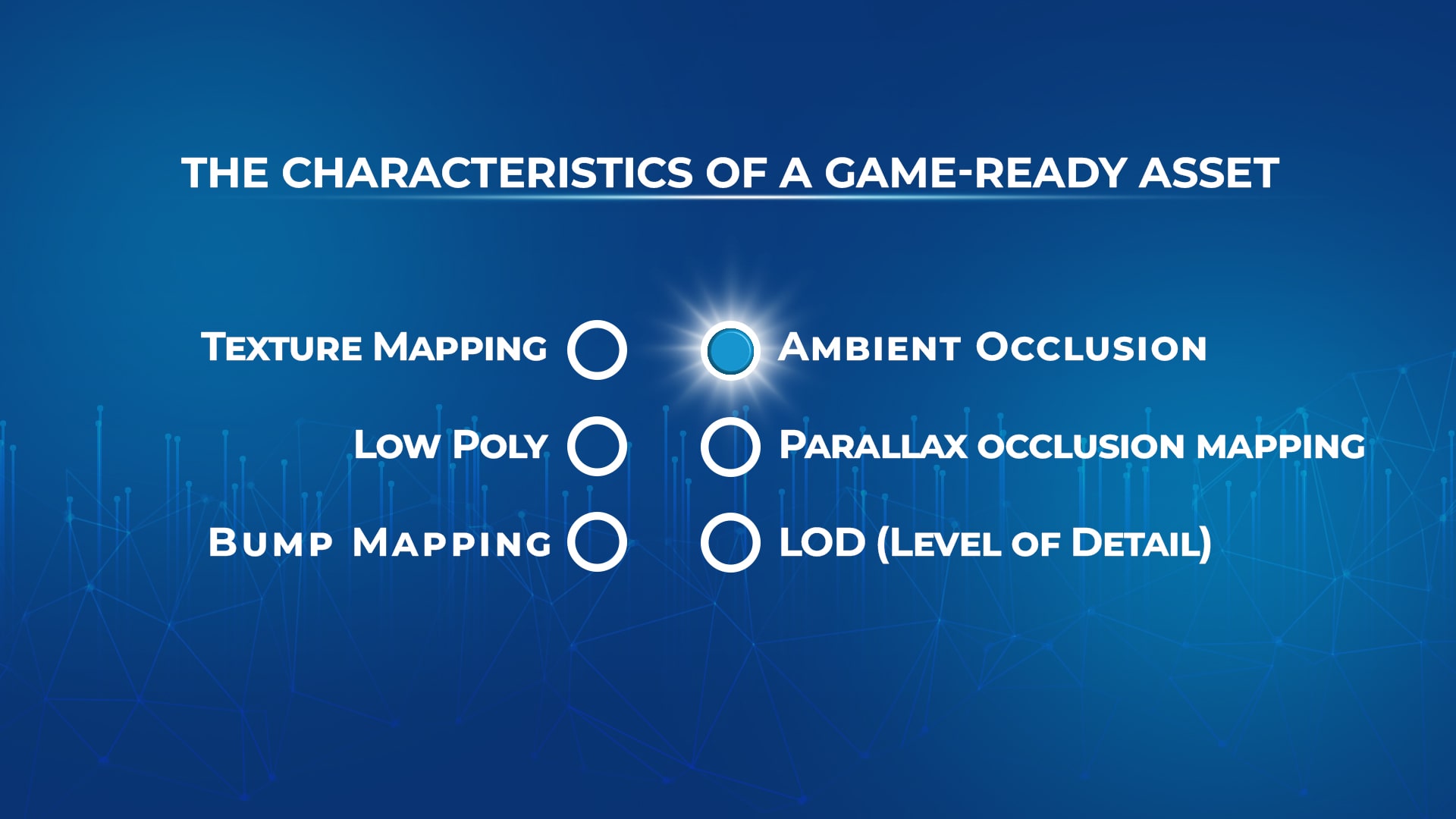
Texture Mapping
Diffuse mapping, a technique that merely transferred pixels from a texture to a 3D surface, was what the term “texture mapping” originally referred to. But now, on a computer-generated visual or 3D model, texture mapping is a technique for defining high-frequency detail, surface texture, or coloring information.
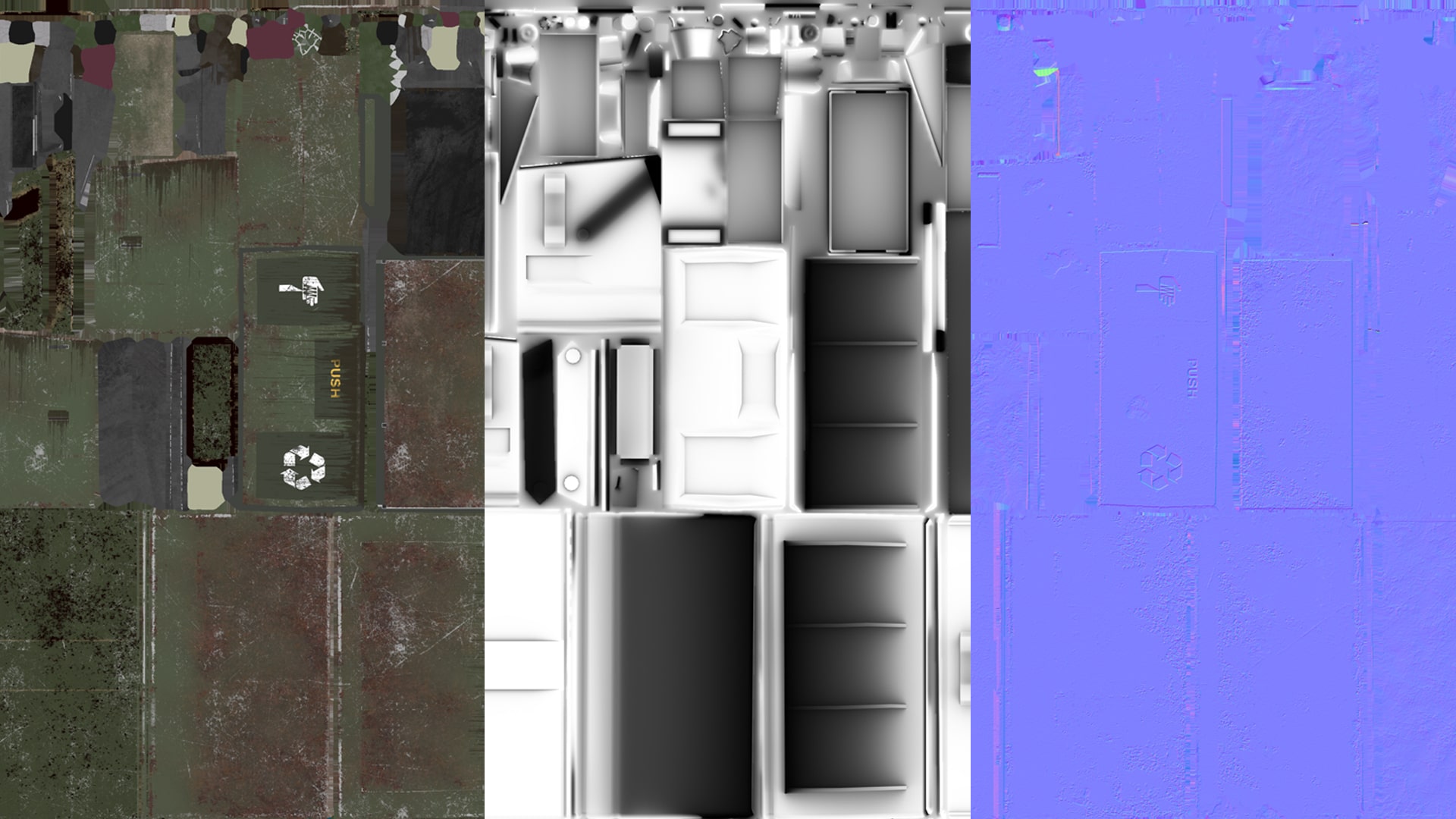
Since the introduction of multi-pass rendering, multi-texturing, mipmaps, and more complicated mappings like height mapping, bump mapping, normal mapping, displacement mapping, reflection mapping, specular mapping, and many other variations, it is now possible to simulate near-photorealism in real-time by drastically reducing the number of polygons and lighting calculations required to create a realistic and useable 3D scene.
Light Baking and Baked Shadows
The precalculation of highlights and shadows for a (static) scene by a program like 3ds Max is known as “light baking,” the results of which are then saved in a lightmap. In order to simulate light, the renderer understands where to make a model brighter or darker.
Performance is improved by light baking only when real-time computations are relieved. In this case, the graphics card can display complex scenes with a higher frame rate. Static lightmaps can be baked with lights that never move; dynamic lights should still function on top of that. Currently, it is impossible to have a light interact with dynamic objects while simultaneously casting a static lightmap shadow.
💡 Pro Tip:
Always name and assign model components to their baking groups with appropriate suffixes, such as _low and _high, before baking.
Nowadays, instead of the outdated practice of “exploding” the item to eliminate baking artifacts, there is a standard workflow. Try organizing all low and high poly pieces into low and high poly groups. Then export as FBX with low and high poly suffixes.
For example, check out this neat light baking naming and grouping by The Rookies.
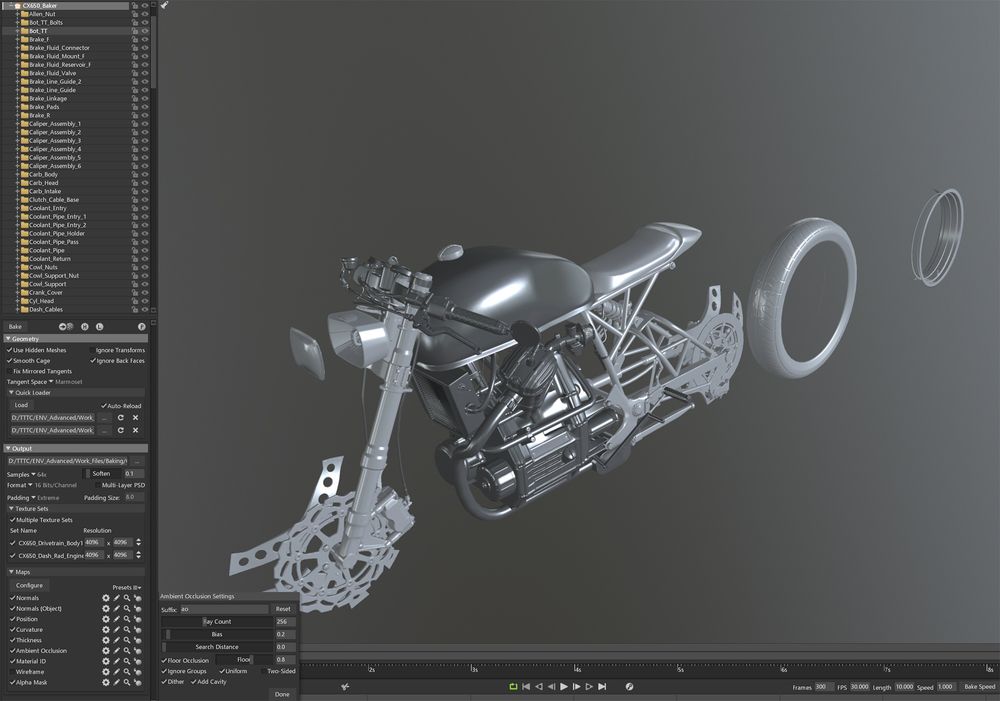
Low Poly
The polygon count of a 3D model has to be brought down to a level where it can be easily managed by a game engine in order for the asset to be rendered effectively. This might imply that a model’s total number of polygons is reduced from millions to hundreds as a result. This procedure is known as “retopology”, and it is often an additional step that a 3D modeler has to conduct to get the asset ready for use in a game.
One of the key reasons gaming-ready models are in demand is this very reason.
One of the most typical methods to accomplish this goal is by repeatedly charting each polygon, which may be a laborious operation. There are automated choices too, but this procedure normally requires some form of personal interaction, which could be really time-consuming.

Occlusion Mapping
Ambient occlusion or Occlusion Mapping is a shading and rendering technique used in 3D computer graphics, modeling, and animation to determine how exposed each point in a scene is to ambient lighting. For instance, the further one travels within a tube; the more occluded (and hence darker) the inside is compared to the exposed exterior surfaces.
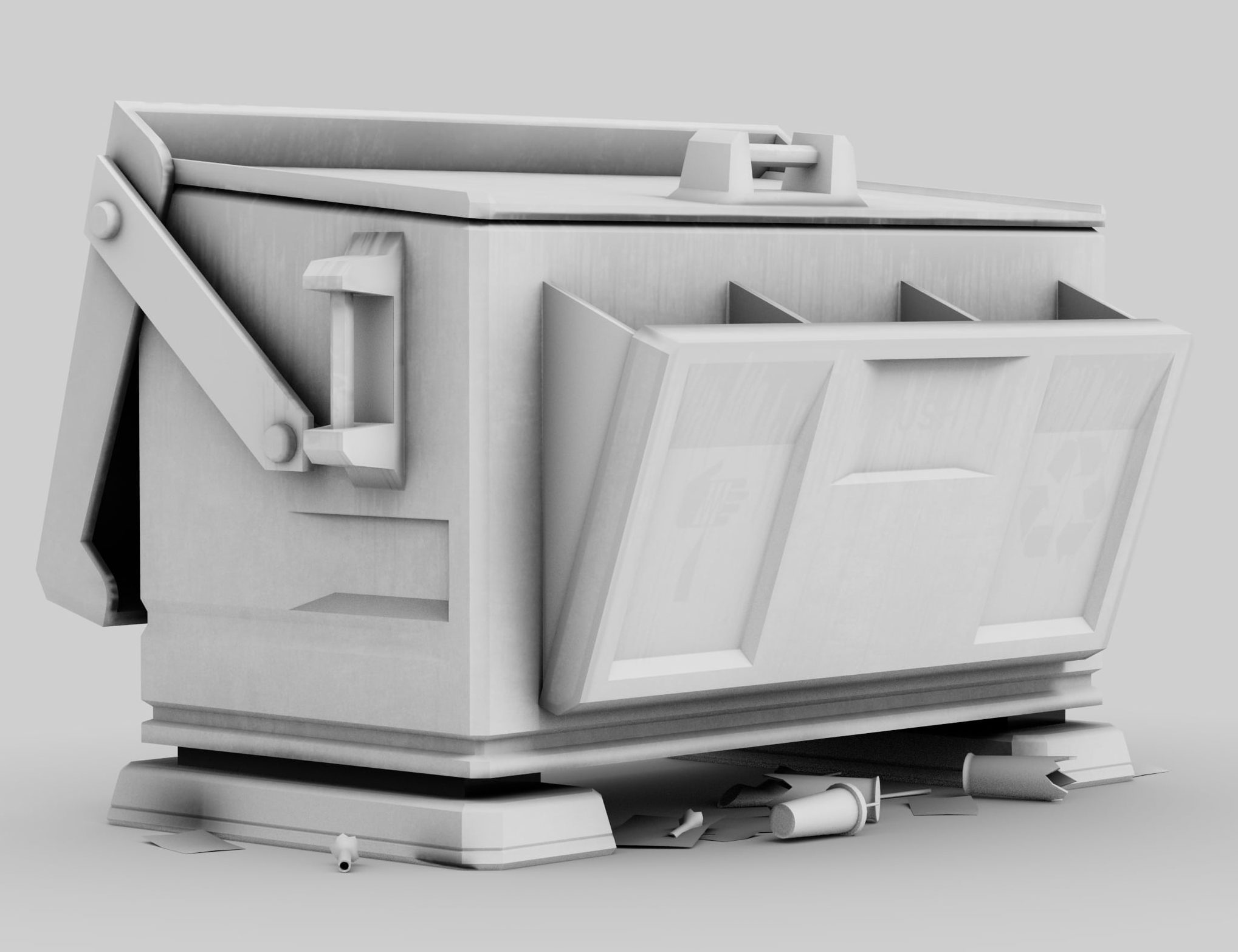
Normal Map
When the poly count of a 3D model is decreased, it is not uncommon for a significant amount of the model’s detail to be lost in the process. By simulating the fine detail of the 3D model, normal maps are able to alleviate some of the impacts of this loss. When applied to a 3D model, a Normal Map is a kind of texture map that, when used to manipulate the way light interacts with the object, helps to achieve the desired effect.
This recreates the loss of fine detail that occurs when the poly count of a model is decreased.
In order to make this map, you will need two different renditions of the same model: one with a high poly count and the other with a low poly count.
Baking is the name of this procedure, which projects the finer details of the high-poly asset onto the low-poly version of the asset.
Bump Mapping
In computer graphics, the method “bump mapping” is used to simulate bumps and creases on an object’s surface. To do this, the normals of the object’s surface are disturbed, and the perturbed normal is used for calculating illumination. Despite the fact that the underlying object’s surface is unaltered, the outcome is an apparent rough surface as opposed to a smooth one. This method lets our game-ready asset look natural and light at the same time.

Parallax occlusion mapping
The technique of parallax mapping has been improved with parallax occlusion mapping (POM). Instead of creating new geometry, parallax occlusion mapping uses a displacement map (similar to a topography map) to procedurally define 3D space in textured surfaces. This frees up the processing cycles needed to produce the same effect using geometry computations, allowing developers of 3D rendering programs to add 3D complexity in textures that appropriately shift relative to perspective and with self-occlusion in real-time (self-shadowing is also feasible).
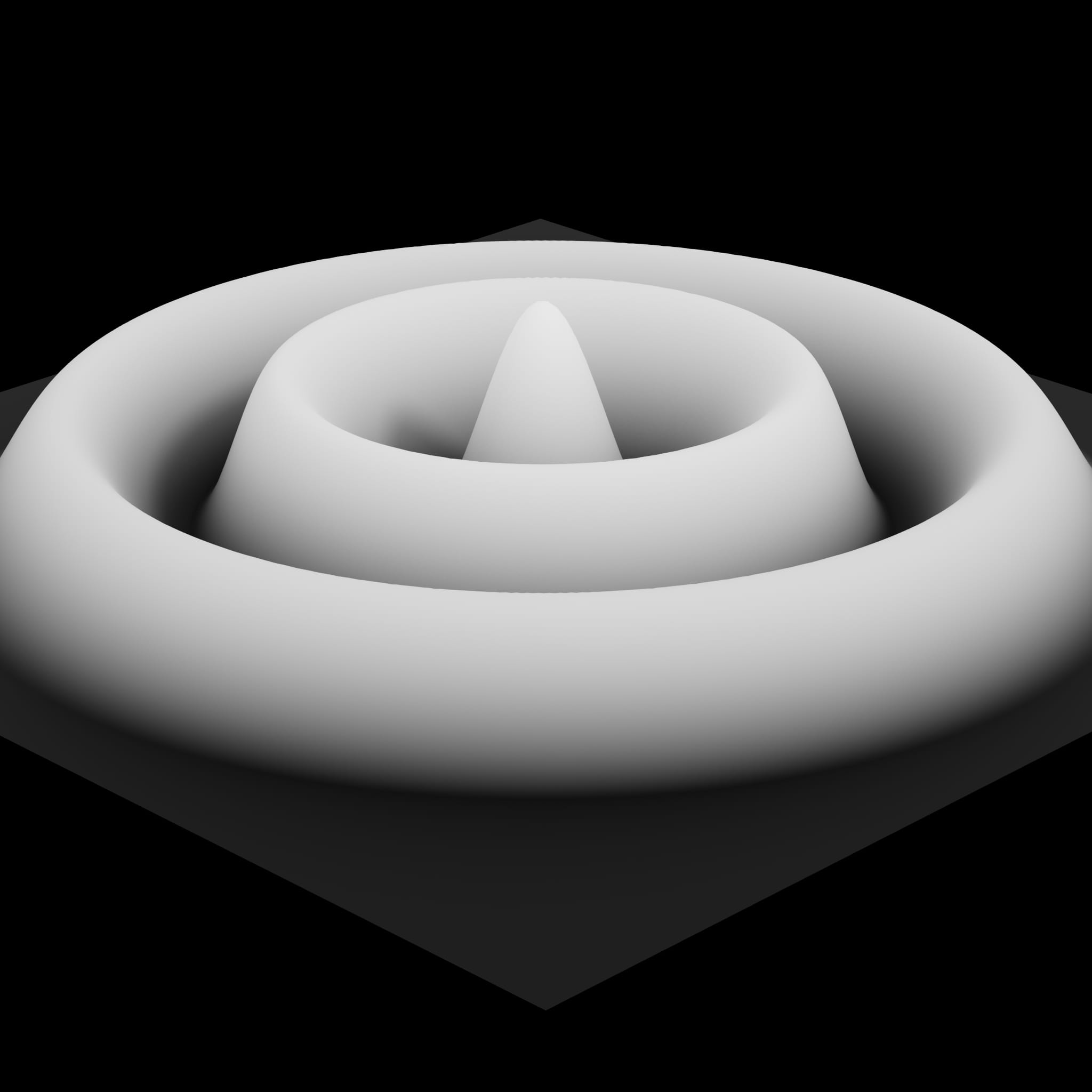
Minimized Texture Resolutions
While there is a focus placed on lowering the poly count, lowering the resolution size of textures is sometimes disregarded. When moving from one texture resolution to another, there can often be a significant increase in size and, therefore, the disk space required.
This jump makes the size about three and a half times bigger. For instance, if you have a texture with a resolution of 512 square pixels by 512 square pixels, the size of this file is around 654 kilobytes, whereas the size of the next larger resolution – 1024×1024 – is approximately 2.17 megabytes. The next size up, 2048×2048, is again three and a half times larger and takes up 7.43 megabytes.
💡 Pro Tip:
Try to give your customers different resolutions. They will be much more comfortable when they have options. Either that, or provide them with the Substance file so they could configure the texture size themselves.
As can be seen, the strain placed on the system’s resources may rapidly accumulate, especially when you consider the possibility that a single model may have more than one texture associated with it. Frequently, game-ready assets come with massive 2k or 4k textures, which, given the level of detail present in the model, are entirely superfluous. The texture sizes of a good game-ready asset are scaled up or down depending on the demands of the asset.
Good UVs
The model to which your texture map is applied is represented in a 2D UV. UVs may be produced in various methods, both automatically and manually. Your asset has to have what is known as “seams” if you want to build a UV.
These seams specify how to unwrap the asset in order to display it in two dimensions. Your textures may sometimes have discrepancies depending on where these seams are positioned.
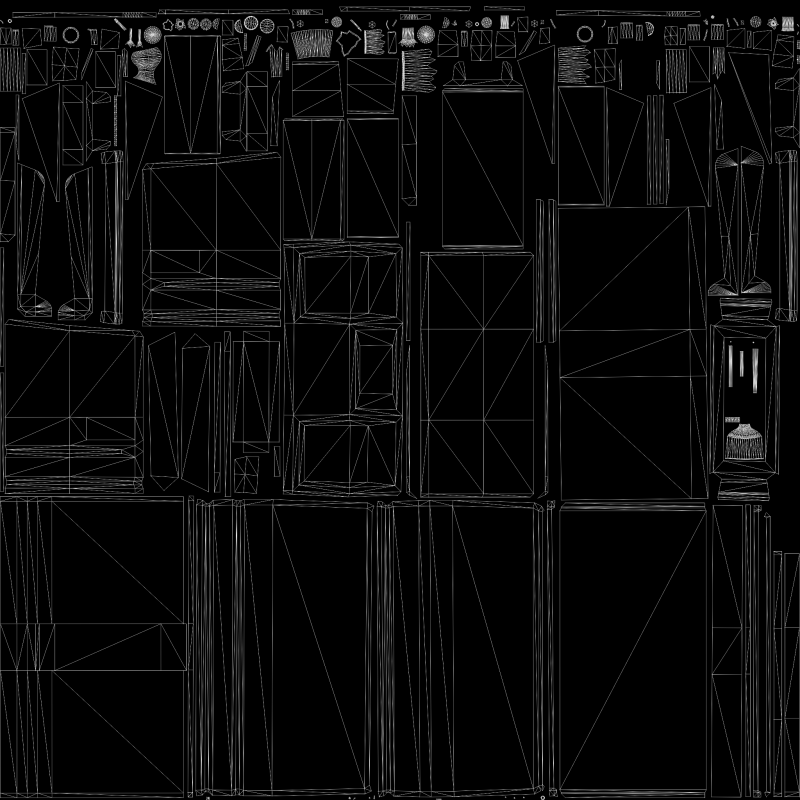
For a model that is just going to be represented as an image, these inconsistencies may not matter as they can be concealed. These might be important for gaming assets since a player could view the model in its entirety.
In a good game-ready asset, these seams are purposefully positioned in unlikely locations, for instance, along sharp edges where the mismatch tends to be less obvious. The asset should use as much area as possible while using a UV, which is the second factor to consider.
If space isn’t used effectively, the asset may need to have higher texture quality to make up for the lost detail.
LOD (Level of Detail)
You may apply what are known as Levels of Detail thanks to an excellent game-ready asset. Here, the asset’s textures may be changed according to how distant the model is from the game camera. This saves resources because you may use a low-poly model and low-resolution texture when the model is distant from the camera, and naturally, a high-poly model and high-resolution texture when it is near the camera. Our professional technical artists at Dream Farm Studios can:
- Provide LOD for your game assets based on your concept and ideas and make them game-ready.
- Create a game-ready asset from scratch using cutting-edge technology and add a Level of Detail on their own.
How does LOD work in a game-ready asset?
You can use LOD if the asset has many versions with scaled poly counts or if the textures have different sizes and resolutions.
Jordan Newman’s model of a gun with different LODs is a good example of what we’re talking about here.
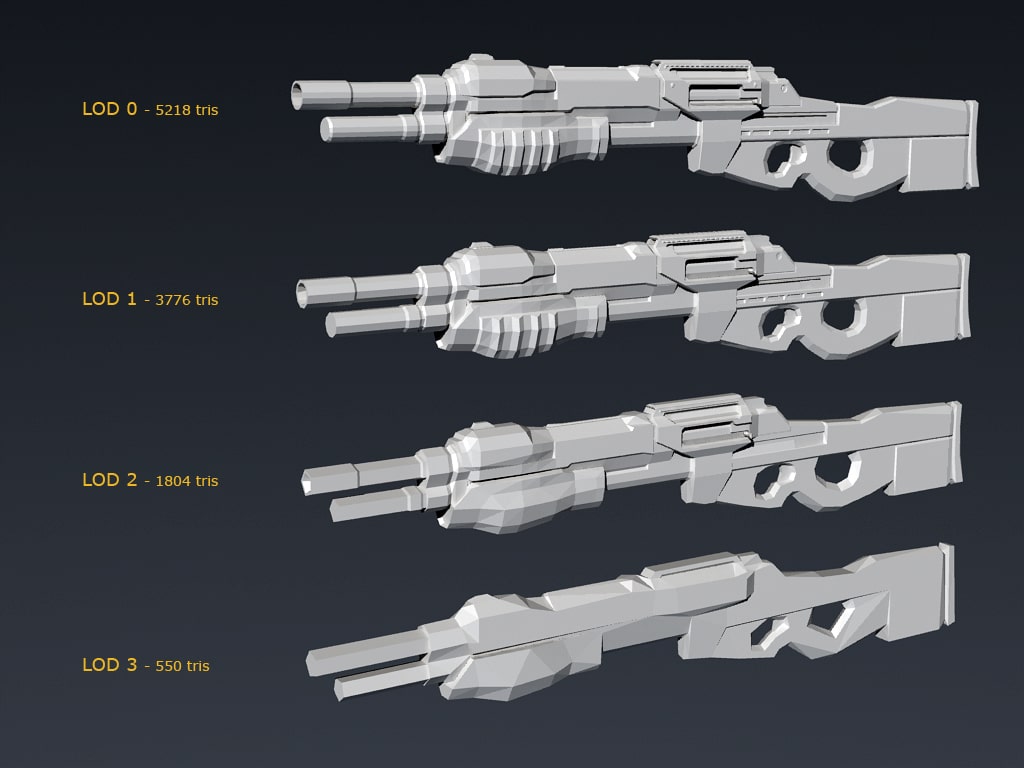
Because it includes altering the model’s geometry to produce its variations, it could take a ton of time to create variants of a model. For this reason, finding models with LOD in any model shop may be challenging.
But don’t worry, we’ve got you! You can always outsource a game-ready asset project.
Go From High Resolution to Game Ready
Going from a high-resolution asset to a game-ready asset is both difficult and time-consuming. If not properly done, your game-ready assets may not function properly on the platform. Regardless of the target device’s capabilities, you should never use more poly than is required.
Unoptimized assets consume power that could be used to provide a more satisfying gameplay or to add a few fps to improve the user experience.
Only non-real-time applications can get away with unoptimized assets, albeit they have their own obstacles.
While you can get assets from online marketplaces like GameDev Market, Sprite Database, Unreal Marketplace, Unity Asset Store, Blender Market, and GoGraph, you should let companies with up-to-date technology and potent specialists provide you with tailored game-ready assets.
Dream Farm Studios: Where You Can Order Game-Ready Asset(s)
Game-ready assets are not your typical assets as they sometimes need a lot of work to be actually Game Ready.
Contact us to book an order or receive a consultation now!
We have a team of 3D specialists and TAs trained in real-time-engine optimization and talented artists working together to create world-class assets for your projects so that you can bring your characters to life and make your stories more entertaining.
Have you ever purchased game assets on online marketplaces? Tell us about your experiences! And also, don’t forget to give us feedback on our article. We’d always love to hear them!

Allen Rafiee
Allen is the Senior blog writer at Dream Farm Studios. In the five years he has been writing for startups and big companies, he challenged himself to learn all he could about digital marketing and finally became a key member of the Marcom team. When he's not doing all of that, you can find him teaching different languages, learning new recipes, and watching cool documentaries about, well, anything!

